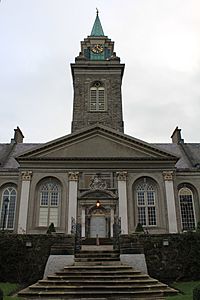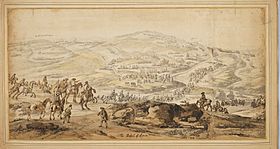Irish Army (1661–1801) facts for kids
Quick facts for kids Irish Army |
|
|---|---|
 |
|
| Active | 1661–1801 |
| Country | Kingdom of Ireland |
| Type | Army |
| Role | Land warfare |
| Size | 7,500 (1661) c. 36,000 (1690) 12,000 (1699–1767) 15,235 (1767–1801) |
| Commanders | |
| Commander-in-Chief | James Butler, 1st Duke of Ormond (1661–1685) Richard Talbot, 1st Earl of Tyrconnell (1685–1689) Frederick Schomberg, 1st Duke of Schomberg (1689–1690) Godert de Ginkel (1690–1692) Lord Galway (1692–1701) Thomas Erle (1701–1705) Lord Cutts (1705–1707) Richard Ingoldsby (1707–January 1712) William Steuart (1711–1714) Lord Tyrawley (1714–1721) Lord Shannon (1721–1740) Owen Wynne, 1728 Gervais Parker (1740–1750) Viscount Molesworth (1751–1758) Lord Rothes (1758–1767) William Keppel (1773–1774) George Augustus Eliott Sir John Irwin (1775–1782) John Burgoyne (1782–1784) Sir William Augustus Pitt (1784–1791) George Warde (1791–1793) Lord Rossmore (1793–1796) Lord Carhampton (1796–1798) Sir Ralph Abercromby, 1798 Lord Lake, 1798 Lord Cornwallis (1798–1801) |
The Irish Army was the official army of the Kingdom of Ireland. This kingdom was closely linked to England and later to Great Britain. The Irish Army existed from the early 1660s until 1801. It then became part of the British Army. For a long time, it was the largest army available to the British monarch. It was even bigger than the armies in England and Scotland.
At first, only the monarch controlled the army. But after 1699, the monarch and the Parliament of England shared control. The Parliament of Ireland took on more duties in 1769. After 1782, it even passed its own laws about the army. The Irish Army was paid for by Ireland's own money. It also had its own top commander, called the Commander-in-Chief, Ireland.
For most of its history, only Protestant members of the Church of Ireland could join. Most Irish people were Catholic. They, along with other Protestants, were not allowed to join. But when the Catholic king James II ruled (1685-1688), Catholics were actively recruited. They quickly became the majority in the army.
When James II was removed from power in 1688, most Irish Army units stayed loyal to him. They fought for him in the Williamite–Jacobite War (1688-1691). After James lost, many of these units went to France. They formed the main part of the famous Irish Brigade.
After the war, the army was rebuilt. It became an all-Protestant force again. But later, due to a shortage of soldiers, some Catholics were allowed to join. This became legal in 1778. Irish soldiers fought for Britain in several wars. These included the Nine Years' War (1688–1697) and the American Revolutionary War (1775-1783). The army also fought against rebels in the Irish Rebellion of 1798. However, other local forces, like the Irish Militia and Yeomanry, did most of the fighting.
After the Acts of Union 1800, the Parliament of Ireland was removed. The Irish Army's regiments then became part of the British Army. The modern Irish Army today does not trace its history back to this older army. Instead, it comes from the Irish Republican Army before 1922.
Contents
Early History of Armies in Ireland
Following the Anglo-Norman invasion of Ireland in the late 1100s, English kings controlled parts of Ireland. This area was called the Lordship of Ireland. The rest of the island, Gaelic Ireland, was ruled by Irish chiefs. Both the English and Irish chiefs had their own armies.
By the 1400s, English control had shrunk to a small area called the Pale. In the 1530s, a rebellion by Thomas FitzGerald, 10th Earl of Kildare showed how weak English forces were. The rebels even attacked Dublin.
In 1542, the Kingdom of Ireland was officially created. Henry VIII of England became King of Ireland. The English then began to take control of the whole island. This involved giving Irish land to Protestant settlers from England. This led to many conflicts, like the Desmond Rebellions and the Nine Years' War. The English won this war in 1603. After 1607, all of Ireland was under English control.
Wars of the Three Kingdoms (1640s)
In the early 1640s, King Charles I allowed a "New Irish Army" to be formed. This army was mostly made up of Catholic Irish people. It was meant to fight in Scotland. But there were rumors that Charles I planned to use this army against his enemies in England.
When the Irish Rebellion of 1641 started, the regular Irish Army was too small. Many soldiers from the New Irish Army joined the rebels. They soon controlled large parts of Ireland. In 1642, they formed the Irish Catholic Confederacy and their own army.
Many English soldiers arrived in 1642 to help the King's supporters in Ireland. Scotland also sent an army. Irish Protestants in Ulster formed their own army, the 'Laggan Army'. The Irish Confederate army fought against these forces. This period is known as the Irish Confederate Wars.
In 1649, a large English army led by Oliver Cromwell invaded Ireland. They captured many towns and conquered Ireland by 1653. The King's Irish army went into exile with Charles II. English republican troops then guarded Ireland until 1660.
The Army is Rebuilt

In 1660, Charles II became King of Ireland again. He kept the large army in Ireland, which was 7,500 soldiers strong. This was the biggest army he had in the British Isles. But many of these soldiers had fought against him before. So, in 1661, the new Viceroy, the Duke of Ormonde, began to change the army.
Ormonde's first step was to create a 1,200-strong regiment of Foot Guards in Dublin. To reduce the influence of old enemies, many new soldiers came from England.
By 1672, the rest of the Irish army was organized into six new regiments. But most soldiers were still spread out in small garrisons. The Royal Hospital Kilmainham was built in 1680 to care for former soldiers. However, soldiers were often poorly paid and equipped. A report in 1676 called the army "in a most miserable condition." Only Protestant Anglicans were allowed to serve. Many officers were inexperienced and sometimes stole money meant for the soldiers.
By 1685, the army had the Foot Guards, six other infantry regiments, and three cavalry regiments. Their main job was to keep peace within Ireland. Two companies of the Foot Guards even served as "sea-soldiers" during a war with the Dutch.
The Army Under King James II

King James II was Catholic. He appointed Richard Talbot, 1st Earl of Tyrconnell, as the new army commander. Tyrconnell wanted to create a Catholic army loyal to James. He removed many Protestant officers and replaced them with Catholics. He also quickly recruited more Catholics into the army. By 1686, two-thirds of the soldiers and 40% of the officers were Catholic.
This change worried many people in Ireland and England. People feared that Irish Catholics wanted to take back their lands. In 1688, James II was removed from power by his Protestant daughter Mary and her husband William of Orange. James had sent 2,500 Irish troops to England. These troops were disarmed when William landed. Their Catholic soldiers were sent to Europe. The remaining Protestant soldiers joined another regiment.
Irish Protestants started a rebellion in 1689. They formed the Army of the North and declared William as king. Tyrconnell kept control of most towns with the units loyal to James. He decided to hold Ireland for James. In January 1689, he greatly expanded the army. Many new regiments were formed, but they often lacked uniforms and good weapons. James's Irish army eventually grew to about 36,000 men.
The Williamite War in Ireland

James II landed in Ireland in March 1689 with French soldiers. He hoped to use Ireland to regain his kingdoms. In August, William's main army landed in Ireland. The war lasted two years and caused many deaths. William's army defeated James's army at the Battle of the Boyne in July 1690. This led to the loss of Dublin. But James's forces held off William at the Siege of Limerick. Both James and William left Ireland in 1690, leaving others to finish the war.
In July 1691, the Battle of Aughrim was fought. This was the bloodiest battle in Irish history. The Irish army's commander was killed, and many officers were captured. This was a huge blow to James's side.
The Treaty of Limerick
In October 1691, a peace agreement called the Treaty of Limerick was signed. It allowed soldiers still loyal to James to leave for France. This event is known as the "Flight of the Wild Geese". About 19,000 Irish soldiers and irregular fighters left. With women and children, the total was over 20,000 people. Some soldiers had to be forced onto the ships.
A separate Irish Brigade had already formed in France. The new arrivals from Ireland joined it. They kept the traditions of the old Irish army. They even continued to wear the red coat uniform. This sometimes caused confusion when they fought the British Army.
William reformed the Irish Army. He used it to recruit soldiers for his international wars. Catholic recruitment was again forbidden. But this rule was often ignored when more soldiers were needed. After a peace treaty in 1697, William wanted a larger army. But the English Parliament passed a law in 1699 to reduce the armies. The English army was cut to 7,000 and the Irish army to 12,000. This law also banned foreigners from both armies.
The Army in the 1700s
For most of the 1700s, the Irish army was used to keep regiments ready for war. These regiments were kept at a lower strength in Ireland. Then, when war broke out, they would recruit more soldiers and be sent abroad. This meant that Ireland was supporting an army mainly for Britain's benefit.
Officially, the army was not allowed to recruit Catholic soldiers in Ireland until 1756. But this rule was often ignored when more soldiers were needed. It was expensive to recruit in Britain. So, officers often secretly enlisted Irish Catholics.
By 1767, British leaders wanted to increase the size of the army. But the British Parliament resisted. So, they decided to increase the Irish army instead. The Irish army's limit was raised from 12,000 to 15,235 soldiers. In 1769, the Irish Parliament agreed to keep these extra troops.
French and Indian War (1754-1763)
The British government used Irish regiments for the French and Indian War in North America. Two regiments from Ireland suffered heavy losses in the Battle of the Monongahela. They continued to serve throughout the war. They took part in the successful attack on Havana before returning to Ireland in 1763.
American War of Independence (1775-1783)
When the American colonies rebelled in 1775, Ireland provided many soldiers for the British Army. The Irish Parliament agreed to send several Irish Army regiments to America. This raised concerns that Ireland was not well defended.
In response, a group called the Irish Volunteers formed. They wanted to defend Ireland from invasion. But the Volunteers quickly became a political movement. They demanded more power for Ireland from London. This led to the Constitution of 1782. This gave the Irish Parliament more control over its own armed forces.
Irish Rebellion of 1798
In the 1790s, the Irish Army was not considered very effective. This was a time when ideas from the French Revolution were spreading. People feared that these revolutionary ideas would reach Britain and Ireland. The army fought against the rebels in the Irish Rebellion of 1798.
Becoming Part of the British Army
The Irish Army became part of the British Army after the Acts of Union 1800. By this time, the ban on Irish Catholics serving in the army had been completely removed. They began to make up a growing number of soldiers.
See also
- Commander-in-Chief, Ireland
- Military history of Ireland

